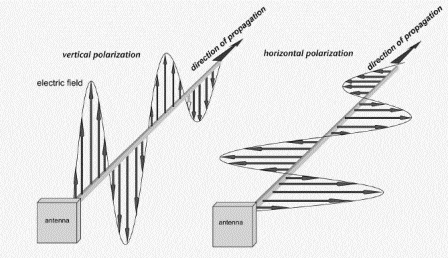One of most important topics when choosing an antenna is being aware of the antenna polarization. Antenna polarization exists due to the fact that all energy travels in the form of a 2-Dimensional wave unlike the 3-Dimensional world that we live in. This physical property of wave propagation can explain why a horizontally polarized antenna has trouble communicating with a vertically polarized signal. Let’s start by looking at a visual representation of these two types of antenna polarization.

Antenna Polarizations and how they radiate
While it may become clear how these waves travel it does not explain why the two are not compatible. The image above represents how the wave is sent from the transmitting antenna and in order for both antennas to communicate efficiently, they must have matching antenna polarizations. Think of the receiving antenna as a coin slot on a vending machine, and the transmitting antenna as a coin. The orientation of the slot on the vending machine can be either vertical or horizontal much like the antenna polarization of the receiving antenna. Now, what happens when you try to insert a coin vertically in a horizontal vending machine coin slot? The same question can be asked when you attempt to transmit a from a vertically polarized antenna, to a horizontally polarized antenna, and the answer is pretty much the same as the vending machine coin slot analogy.
In a scenario where you have direct line of sight between the transmitting and receiving antenna, the antenna polarization will have to line up for the two antennas to communicate efficiently. It isn’t impossible for two different polarized antennas to communicate but it is severely limited, and often made possible due to refraction and reflection of the signal. Generally speaking, it is a good rule of thumb to match polarizations when utilizing linear polarized antennas. Most antennas today transmit and receive using vertical polarization. In the real world those waves reflect off of everyday objects, which can change the polarization of the wave. This would lead to a decreased signal strength at the receiving antenna. Stay tuned for next week’s #Techtuesday where we will be covering Multi-Polarized antennas and how they solve polarization mismatch, polarization refraction, and polarization reflection.
MP Antenna, LTD. (https://www.mpantenna.com) is the exclusive developer and manufacturer of advanced Multi-Polarized antennas that are well-suited for a range of applications including public safety, wireless broadband systems, WiFi, WiMax, video monitoring systems, 3G, CDMA, GSM, PCS and LTE. The company’s product line improves signal penetration and connectivity in obstructed deployments providing increased data throughput, enhanced voice clarity and multi-path mitigation. MP Antenna’s products are protected under numerous US patents with many US and foreign patents pending. MP Antenna is privately held and designs and manufactures its products at their headquarters located near Cleveland, Ohio, USA.
